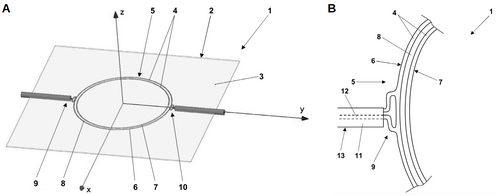Filter unit with microwave resonator
Presented here is a filter unit that has one or multiple microwave resonators integrated into its filter material, whereby filter load can be monitored during operation. Thus, filter exchange intervals can be adjusted to actual filter capacity.
Challenge
The efficiency of filter units is essentially dependent on filter load with filtered particles. There are several options to determine the filter load. For example, pressure drop over the filter unit or its mass increase, due to load with filtered material, can be used as measures. Both methods are complex, for the latter for instance, the filtration process needs to be interrupted. If actual filter load cannot be determined, filter units have to be exchanged or regenerated in certain time intervals that correlate with estimated load build-up that would compromise its proper function. A missing monitoring option therefore often leads to filter exchanges that are not yet necessary. Monitoring filter load during operation can thus help saving costs.
Our solution
Presented here is a filter unit that has one or multiple microwave resonators integrated into the filter material (Fig. 1):

Fig. 1 A) Schematic of a microwave resonator (5) integrated into a filter unit (1), consisting of conducting material (4), in form of an outer (6) and an inner ring (7), separated by a gap (8) of filter material (3), inside the filter layer (2). The resonator is coupled by two electromagnetic couplings (9, 10). B) Coupling in form of an autotransformator with a conducting connection between the outer (11) and inner conductor (12) of a coaxial cable (13), that spreads along a section of the outer ring (6) of the microwave resonator's (5) conducting material (4). (Source: Schimmack, Taute, Höft)
Foreign material that is added into the electromagnetic field of a microwave resonator, shifts the resonance frequency of a triggered microwave and dampens its resonance circuit (Fig. 2B/C). Thus, if a microwave resonator is part of a filter unit (Fig. 1/2A), the induced microwaves are affected by the accumulating filtered material, and it can thus be used to draw conclusions about filter load or even the composition of the filtered material itself. Integration of a microwave resonator into a filter unit can easily be accomplished by sewing or embroiding conductive material, in form of fibres or thin wires into (Fig. 2A), or by printing or spraying of it onto the filter material. Thus, production of such filter units, for example as disposable filters, can still be realized cost-effectively.
Advantages
- Cost savings due to adjusted filter exchange cycles
- In-process monitoring of filter loads
- Analysis of filtered material
- Filter damage or failure notification
- Cost-effective production possible (e.g. disposable filters)
Applications
- Filtration of contents out of gases or potentially also fluids
- Suitable for various filter materials, including porous ceramics, woven fabrics or fleeces
- Well suited for filter technologies in industrial applications or safety technologies such as industrial waste air, safety at work, fire service and disaster control
Development status
Simulations were conducted and a prototype was built and measured (Fig. 2).

Fig. 2: Experimental measurement of a filter unit with integrated microwave resonator under load. A) Prototype of a respiratory filter unit (1) with a microwave resonator implemented into the filter material (2), consisting of an outer (3) and an inner ring (4). The microwave resonator is coupled via capacitive couplings (5, 6). C) Measured insertion loss of a microwave resonator-equipped filter unit under influence of an increasing load of beech particles. C) Plotted regression line, illustrating the measured frequency shift (MHz) under load with beech particles (mass in mg). (Source: Schimmack, Taute, Höft)
Patent Status
DE patent granted: DE102017122809B3
International patent application: WO2019063618A1
Applicant:
Leuphana University of Lueneburg public law foundation
Christian-Albrechts-University Kiel
References
Recent publication by the inventors:
Metal-Polymer Hybrid Embroidered Microwave Multiresonator for High-Frequency Sensing: Modelling, Simulation, and Experimental Analysis
IEEE - 2018 48th European Microwave Conference (EuMC)
DOI: 10.23919/EuMC.2018.8541718
M. Schimmack, W. Taute, M. Höft
Preliminary work of the inventors:
Modelling, Simulation and Experimental Analysis of a Metal-Polymer Hybrid Fibre Based Microstrip Resonator for High Frequency Characterisation
Procedia Engineering 168, 2016, Pages 975 - 978
M. Schimmack, W. Taute, M. Höft
Contact
Dr. Mirza Mackovic
Patent Manager Technology
E-Mail: This email address is being protected from spambots. You need JavaScript enabled to view it.
Tel.: +49 (0) 551 30 724 153
Ref: CPA-2020-ULue
www.sciencebridge.de
